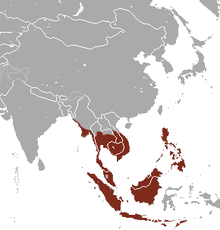Crab-eating macaque
From Wikipedia, the free encyclopedia
| Crab-eating macaque[1] | |
|---|---|
 | |
| Scientific classification | |
| Kingdom: | Animalia |
| Phylum: | Chordata |
| Class: | Mammalia |
| Order: | Primates |
| Family: | Cercopithecidae |
| Genus: | Macaca |
| Species: | M. fascicularis |
| Binomial name | |
| Macaca fascicularis Raffles, 1821 | |
 | |
| Crab-eating macaque range | |
| Synonyms | |
The crab-eating macaque (Macaca fascicularis), also known as the long-tailed macaque, is a cercopithecine primate native to Southeast Asia. It is referred to as the cynomolgus monkey in laboratories.[2] It has a long history alongside humans;[7] they have been alternately seen as agricultural pests,[8] sacred animals in some temples,[9] and more recently, the subject of medical experiments.[7] The crab-eating macaque lives in matrilineal social groups with a female dominance hierarchy,[10] and male members leave the group when they reach puberty.[11] They are opportunistic omnivores [12] and have been documented using tools to obtain food in Thailand and Myanmar.[13] The crab-eating macaque is a known invasive species and a threat to biodiversity in several locations, including Hong Kong and western New Guinea.[2] The significant overlap in macaque and human living space has resulted in greater habitat loss,[7] synanthropic living, and inter- and intraspecies conflicts over resources.

Комментариев нет:
Отправить комментарий